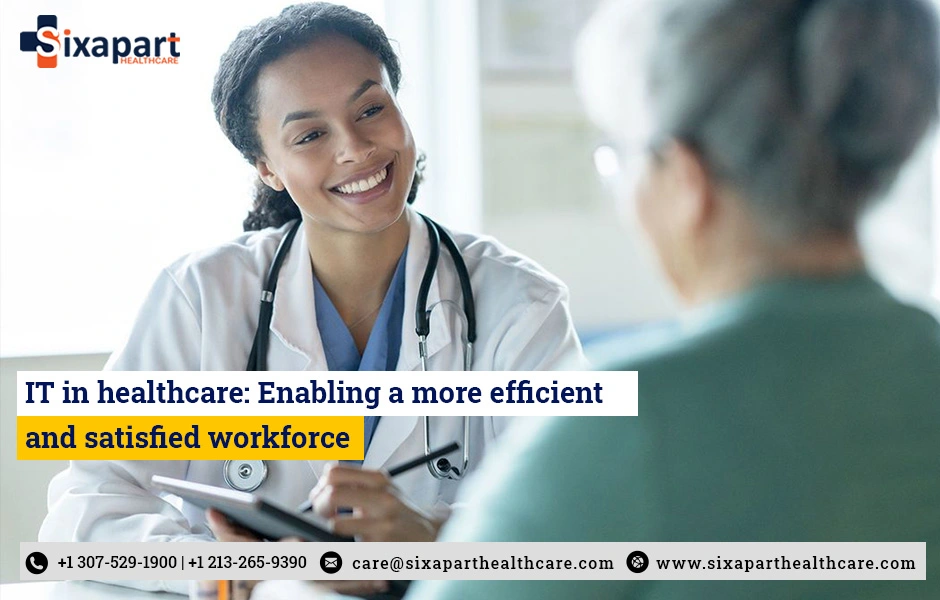IT in healthcare: Enabling a more efficient and satisfied workforce
Blog Source From : https://www.healthcaredive.com/

People who dedicate their careers to healthcare often do so because of a deep desire to help others—whether they are struggling with illness, recovering from accidents, or experiencing life-changing events like childbirth. Highly trained caregivers like doctors, nurses and medical technicians depend on advanced technologies in many areas—from patient diagnosis to lab tests to surgery centers—to make their jobs as efficient and error-free as possible. This helps reduce stress and burnout for an often overburdened workforce to provide better patient outcomes.
Increasing healthcare efficiency with information technology
Information technology (IT) is integral to the daily routines of healthcare frontline workers. For example, they need instant access to medical histories and the latest imaging results, as well as automated processes for scheduling patient visits and ordering tests.
In emergencies, the IT infrastructure plays a critical role when medical decisions have to be made instantly based on access to the latest diagnostics. Real-time video connectivity is invaluable when a distant medical expert needs immediate consulting to determine a treatment path.
The performance of these healthcare applications and services working in unison depends on high-availability networks. And with so many mobile devices in the hands of doctors and nurses, reliable and fast Wi-Fi in all work areas is a top priority for healthcare staff.
Patients benefit from a comprehensive IT infrastructure too. The more information they have, when they need it, provides a better sense of control over their care. Being able to log in to a provider’s patient portal to view test results, ask questions and schedule appointments empowers patients to control their treatment paths. However, all the PII and PHI data traveling over internet connections to home computers and mobile devices need protection against ransomware, hacking and privacy violations. This is where security technologies such as multi-factor authentication and zero trust can be layered into existing processes to prevent unauthorized access to sensitive information and keep patient data safe.
What healthcare workers and patients don’t need is inefficient processes and outdated information systems that distract staff from providing the best and most efficient care. IT systems supporting healthcare workflows should run seamlessly behind the scenes and be nearly invisible to those who rely on them. However, the applications that medical personnel depend on need to be able to respond quickly to maximize time with patients. These newer applications are likely to be cloud-based to be accessible anywhere healthcare workers are situated—in the clinic, lab, ambulance, or operating room. Application quality of experience is critical to limit delays when working with patients. Accessing the correct data quickly is vital in emergencies when response time is measured in heartbeats. Here again, the network that connects staff computers and mobile devices to cloud applications must maintain high availability and fast response times to support the best experiences.
Automation improves IT and OT support staff efficiency too
Supporting frontline healthcare workers are many systems that monitor medical supply levels, track medical equipment and monitor building and patient safety through various operational technology (OT) devices such as cameras, temperature and occupancy sensors and security systems. The workforce behind these solutions manages the physical and information infrastructure of healthcare facilities from hospital complexes to satellite clinics to labs—all the way to homes where 24-hour monitoring of vital signs enables patients to heal comfortably while under automated watchful care.
As IT becomes completely interwoven into nearly every aspect of healthcare, keeping those systems running efficiently while expanding patient services is just as important as preparing the operating room. Automating data entry tasks, scheduling procedures that involve a team of specialists and providing patient self-service portals make staff more efficient and better able to focus on the personal aspects of patient care. Automation also helps hospital administrators manage staffing workloads to minimize overtime and avoid understaffing—and burnout.
Focus on people for better healthcare outcomes
When evaluating the role of IT in healthcare, the people at the center of it all—patients, nurses, technicians and doctors—are the real story. If an application, workflow, or automated warning system can make healthcare workers and operational staff more efficient in accomplishing routine and emergency tasks, then more time can be spent improving patient outcomes. When patients feel that they are getting the attention and results they need, then the systems behind the scenes are working as intended to deliver optimal care.

 Previous Post
Previous Post Next Post
Next Post